Bucket Group Effect of the Composite Multi-bucket Structure
2014-07-30ShuchengJinYanhuaYangandYongtaoZhang
Shucheng Jin, Yanhua Yang and Yongtao Zhang
Technology Center, The Second Harbour Engineering Co., Ltd., Wuhan, 430040, China
1 Introduction1
The bucket foundation is a new type of offshore structure foundation which includes one or more cylinder structures with a closed top and an open bottom. The tubular steel foundations are installed by sealing the top and applying suction inside the bucket. The hydrostatic pressure difference and the deadweight cause the foundation to penetrate the soil.This benign installation procedure allows the buckets to be connected to the rest of the structure before installation,enabling a reduction in the number of steps of required for the installation procedure. Compared with the traditional marine base, the bucket foundation has such characteristics including low cost, short installation period, low installation cost and it is reusable. Moreover, due to the shallow buried depth, the site investigation costs decrease, which is quite suitable for the deep-sea.
Currently the bucket foundation has been tried in practice in the Norwegian oil and gas fields in the North Sea and in Angola. In 1994 and 1995, two large jacket platforms, the Europipe16/11-E and the Sleipner Vest SLT of the Norwegian National Oil Company were established in North Sea area with the water depth of seventy meters(Houlsbyet al., 2005; Ibsenet al., 2008). Thereafter, some
multi-bucket foundations, such as the negative pressure tripod bucket basis, the SIS-IV Self-installation platform and the Bucket foundation breakwater have been developed,as shown in Fig. 1 (Senders, 2005). In recent years, a large number of suction-based offshore platforms have been established in the North Sea, the Gulf of Mexico, the Gulf of Guinea, and offshore of Brazil. But the design specifications of the bucket foundation have not yet been established. However, these investigations are based on the single-bucket structure; the failure mode and bearing capacity characteristics of the multi-bucket structure are not clear, and lack theoretical analysis and experimental research (Liingaardet al., 2007; Sun, 2009; Liet al., 2010).Therefore, a multi-bucket structure is used for the study of the bearing capacity and bucket group effects of the composite multi-bucket structure in this paper.
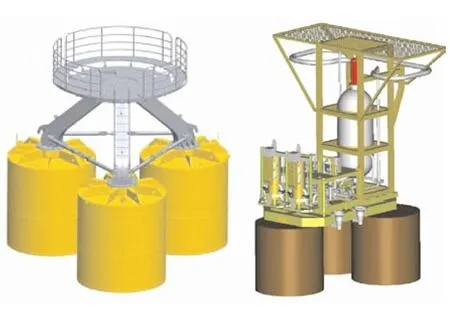
Fig. 1 Composite multi-bucket structure
2 Experimental researches
The physical model tests in this article were conducted using the soil bin testing system of Southeast University. The fine sand is taken as the model soil to study the bearing capacity of the single bucket and four-bucket foundation (Luet al., 2005; Luet al., 2006), and the test models are shown in Fig. 2.
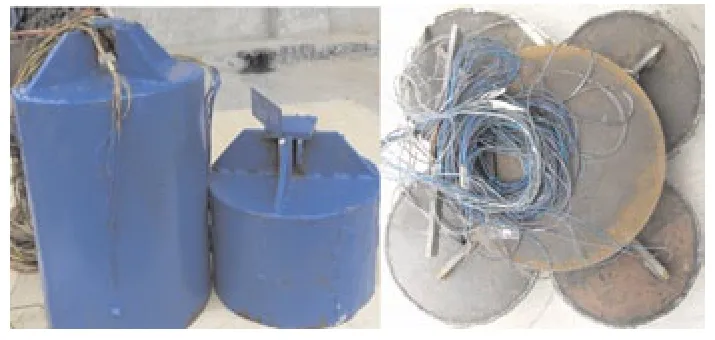
Fig. 2 The test model
The structure dimensions of the test models are shown in Table 1.

Table 1 The model dimensions cm
The Settlement curves of the single bucket and four-bucket foundation are shown in Fig. 3 and Fig. 4.
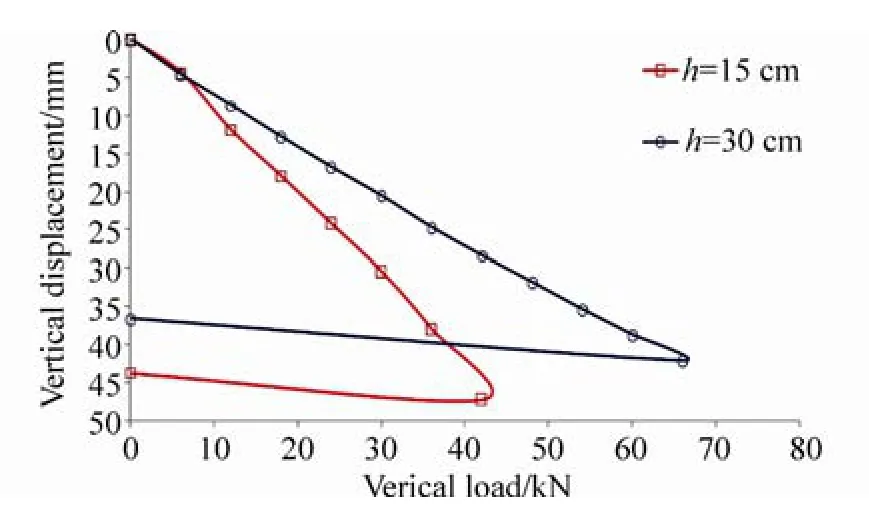
Fig. 3 Settlement curves of the four-bucket foundation
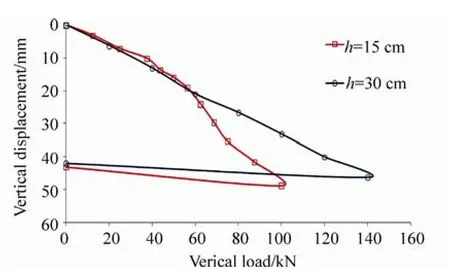
Fig. 4 Settlement curves of the single bucket foundation
As shown in Table 2, the ultimate bearing capacity of the four-bucket foundation is nearly 2.4 times than that of the single bucket, which can be explained by that the bucket group effects having a much greater effect on the bearing capacity of the multi-bucket foundation.

Table2 Comparison of the ultimate bearing capacity
3 Finite element analyses
3.1 Constitutive model
For the bucket foundation, the damage is generally produced by the destruction of the soil around the bucket,which leads to then lead to the structural failure, but at this point the bucket is still in the elastic deformation stage.Therefore, with the finite element analysis a linear elastic constitutive model is taken to simulate the bucket. Earlier studies have shown that the vertical load transferred from the superstructure is mostly bored by the bucket cover. As the bucket cover is usually strengthened with stiffeners, a rigid model is used in this analysis. In this paper we only studied the interaction between the structure and foundation of the bucket, the deformation of the upper steel trusses is not taken into account, thus the connections between the buckets are assumed to be rigid (Alloteyet al., 2008; Andersenet al.,2009).
In this paper, by using friction contact pairs of ABAQUS the contact and fitting between the side wall, the internal and external soil are simulated. The calculation range of the foundation soil is 10 times that of the bucket diameter in the horizontal direction, and 10 times that of the bucket height in the vertical direction, this area range can basically eliminate the boundary effects according to the correlation study(Zhanget al., 2010).
The modified Drucker-Prager material model is applied to simulate the characteristics of the soil. Since the marine soil is in a saturated condition all the time, the Non-Drainage total stress analysis method was utilized in this paper (Varunet al., 2009; Wu, 2007). In addition, the top of the soil is free, other soil surfaces are all under the condition of fixed constraints. The calculated parameters of the soil are shown in Table 3. whereEsis the average deformation modulus,uis the poisson ratio,cis cohesion,φis the internal friction angle,Rfis the damage ratio.

Table 3 Calculation parameters of foundation soil
The bucket is a steel-made structure, elastic modulus E is 210 GPa, poisson ratio u is 0.3. The soil and bucket are divided with solid elements, and the finite element analysis model of the single bucket is shown in Fig. 5.

Fig. 5 Finite element analysis models
In this paper, the displacement control method is adopted to analyze the ultimate bearing capacity of the bucket structure under vertical loads. The displacement is applied by steps at the center of the steel frames between buckets,thus the settlement curves and ultimate bearing capacity are gained.
3.2 Calculation program
In order to analyze the effects of the soil type, the ratio of bucket length to diameter ratioL/D, the ratio of the bucket spacing to the bucket diameterS/D, and the bucket number n,on the bearing capacity of the multi-bucket structure, three numerical analysis programs were executed, with the results shown in can be shown in Table 4. In the following analysis,the diameterDof the buckets is all taken as 4m. Then settlement curves (P-S curve) and the vertical static capacity adjustment factorvηwere obtained from every numerical analysis program, respectively.

Table 4 Calculation programs
3.3 The vertical Static Capacity adjustment factor
The finite element analysis model of the single-bucket structure was established to analyze the failure mechanism of the bucket structure foundation under a monotonic vertical load.
The similar calculation model is also used to analyze the failure mechanism of the double bucket structure. The ratio of the bucket spacing to the bucket diameterS/D=1.
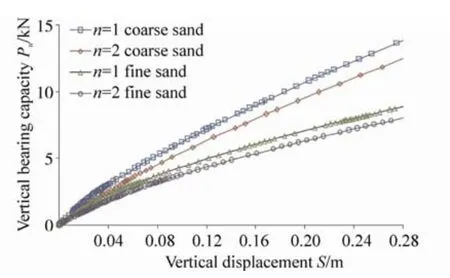
Fig. 6 Settlement curves of single bucket and double bucket
Settlement curves of the single bucket and double bucket foundation are shown in Figure 6. From the settlement curves,we can see that the elastic phase of the curve is very short in the overall process of settlement, and the local shear loss appears subsequently. The settlement curve is a slowly varying curve, which is similar to the local shear failure form of gravity shallow foundations. And the curve doesn’t have an obvious second inflection point, which indicates that the structure has a large carrying capacity for growth. The settlement amount is taken to evaluate the ultimate bearing capacity of the foundation; the corresponding load to settlement of 0.07Dis taken as the vertical bearing capacity of the foundation according to the reference. The calculation results are shown in Table 5.

Table 5 Bearing capacity results kN
Based on the analysis above, there is interaction between buckets, the vertical bearing capacity is not equal to the sum of the single bucket`s bearing capacity. Therefore, the vertical static capacity adjustment factorvηis taken to evaluate the ultimate bearing capacity of the multi-bucket foundation.vηrepresents the ratio of the average vertical ultimate bearing capacity of the multi-bucket foundation to the vertical ultimate bearing capacity of the single bucket foundation:

whereis the average vertical ultimate bearing capacity of the foundation bucket, anduPis the vertical ultimate bearing capacity of the single bucket foundation.
According to the stress characteristic parameters of the multi-bucket foundation, the influence parameters for vηincludes the soil type, the ratio of length to diameterL/D,the ratio of the bucket spacing to the bucket diameterS/D,and the bucket number n. The single factor analysis method is used to respectively analyze the parameters above.
4 The influential factors
4.1 The influence of L/D on the bearing capacity of the multi-bucket structure
According to the scheme program 1, the settlement curves of the four-bucket foundation in the fine sand layer and the coarse sand are obtained. As shown in Fig. 7 and Fig. 8, the ultimate bearing capacity of the four-bucket foundation shows a tendency of increasing withL/D, as theL/Dincreases, the side friction of the buckets increase, thus the ultimate bearing capacity of the foundation bucket is also increased. The curves ofvηandL/Dare given in Fig. 9,wherevηis decreasing withL/D; this is due to the fact that the contact zone of the contiguous buckets increases withL/D, thus the interaction of the buckets has been enhanced.It is worth mentioning that thevηof the coarse sand is a little higher under the same condition.
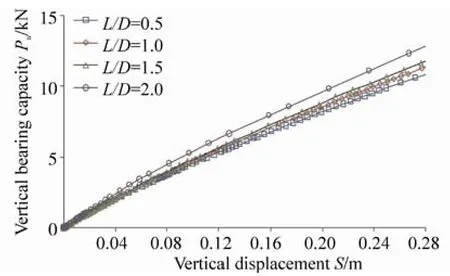
Fig. 7 Settlement curves of coarse sand layer(L/D)
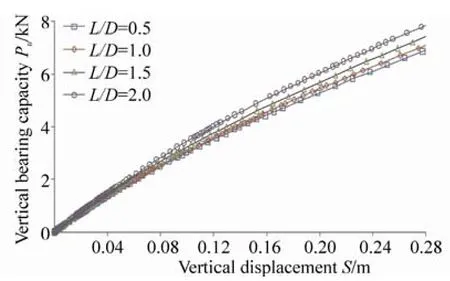
Fig. 8 Settlement curves of the fine sand layer(L/D)
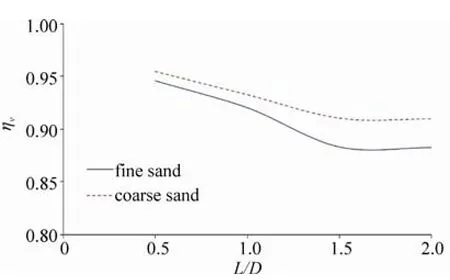
Fig. 9 Curves of vη and L/D
4.2 The influence of S/D on the bearing capacity of the multi-bucket foundation
According to the scheme program 2, the settlement curves of the four-bucket foundation in the fine sand layer and the coarse sand are given in Fig. 10 through Fig. 12,where the ultimate bearing capacity of the four-bucket foundation increases withS/D, and this is due to the fact that the interaction of the contiguous buckets is decreasing with the increasing of theS/D. Furthermore, the vηdecreases withS/D, and thevηof the coarse sand is a little higher at the same condition.
4.3 The influence of the bucket number n on the bearing capacity of the multi-bucket foundation
According to the scheme program 3, the settlement curves of the bucket foundation when the bucket number n is 1, 2, 4, or 9 in the fine sand layer and the coarse sand are given in Fig. 13 and Fig. 14. It can be seen that the settlement curves of the different bucket number foundations are still slowly varying, and the average vertical ultimate bearing capacity of foundation bucketis decreasing with bucket numbern. In Fig. 15 thevηis decreasing with bucket numbern, which implies that the interaction of contiguous buckets have been enhanced. In addition, thevηof the coarse sand is a little higher than that of the fine sand at the same condition.
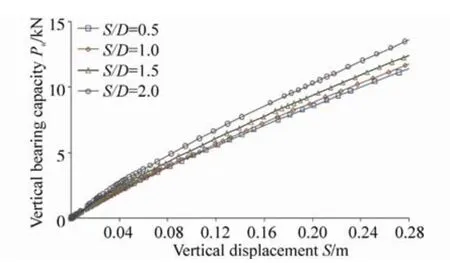
Fig.10 Settlement curves of the coarse sand layer (S/D)

Fig.11 Settlement curves of the fine sand layer (S/D)
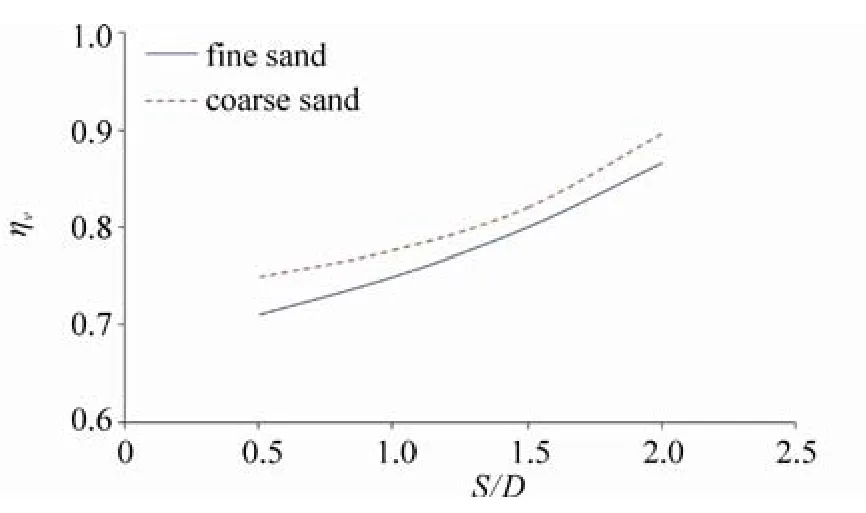
Fig.12 Curves of vη and S/D

Fig.13 Settlement curves of the fine sand layer (n)

Fig. 14 Settlement curves of the coarse sand layer (n)
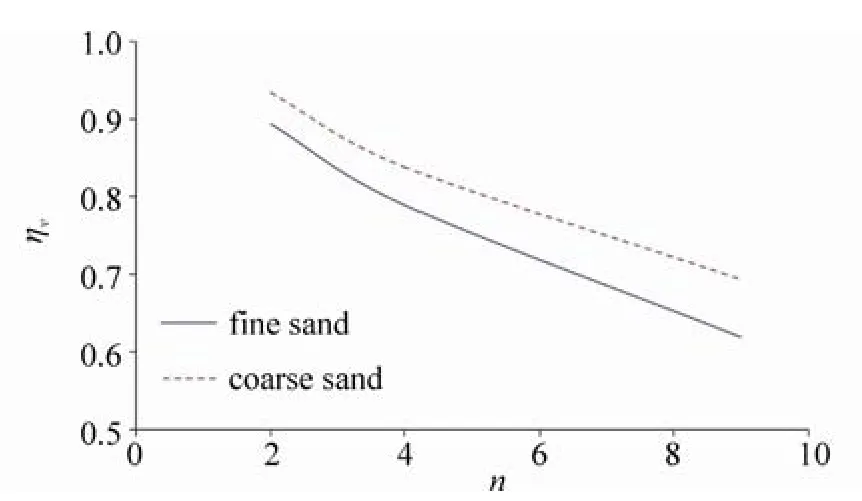
Fig.15 Curves of vη and n
5 Conclusion
According to the features of the bucket foundation, the combination multi-bucket structural is analyzed by using the ABAQUS nonlinear finite element analysis program. By using the displacement control method, the vertical bearing feature of the multi-bucket structural is studied and the bucket-soil-bucket interaction is considered to evaluate the group effects of the multi-bucket foundation. Compared with the experimental data, the bearing capacity and the bucket group effects are analyzed. The calculation and analysis indicate the following conclusions: as follow:
1) The vertical bearing capacity is not equal to the sum of the single bucket`s bearing capacity. There is a non-negligible interaction between the multi-bucket structures.
2) The bucket group effect is related to the configurations and layout of the multi-bucket structure; meanwhile, it`s also subjected to foundation soil.
The conclusions above show that the bucket group effects have a substantial impact on the bearing capacity of the multi-bucket foundation. This is an important factor which needs to be considered in the engineering practice.
Allotey N, El Naggar MH (2008). Generalized dynamic winkler model for nonlinear soil structure interaction analysis.Canadian Geotechnical Journal, 45(4), 560-573.
Andersen L, Ibsen L, Liingaard M (2009). Lumped-parameter model of a bucket foundation.Computational Geomechanics,ComGeo, 731-742.
Houlsby GT, Ibsen LB, Byrne BW (2005). Suction caissons for wind turbines.International Symposium on Frontiers in Offshore Geotechnics, Perth, 75-93.
Ibsen LB (2008). Implementation of a new foundations concept for offshore wind farms.Proceedings of the 15th Nordic Geotechnical Meeting, Sandefjord, 19–33.
Li Chi, Lu Xiaobing, Wang Shuyun (2010). Study on the capacity degradation of bucket foundation in liquefied sand layer under cyclic loads.The Open Ocean Engineering Journal, 10(3),86-92.
Liingaard M, Andersen L, Ibsen L (2007). Impedance of flexible suction caissons. Earthquake Engineering and Structural Dynamics. 36(13), 2249-2271.
Lu XB, Wang SY, Zhang JH, Sun GL, Shi ZM (2005).Experimental study of pore pressure and deformation of suction bucket foundations under horizontal dynamic loading.China Ocean Engineering, 19, 671-680.
Lu Xiaobing, Jiao bintian, Liu Liang (2006). Experimental Study on the Bearing Capacity of Bucket Foundation in Saturated Sand.Geotechnical Engineering Technique, 20 (4), 170-174.
Senders M (2005). Tripods with suction caissons as foundations for offshore wind turbines on sand,Proceedings of International Symposium on Frontiers in offshore Geotechnics, Perth,917-934.
Sun Xiyuan (2009).A Study on Working Mechanism and Bearing Capacity Performance of Bucket Foundation in Soft Ground under Lateral Loads.Ph.D. thesis, Dalian University of Technology, Da Lian, 19-26.
Varun Assimaki D, Gazetas G (2009). A simplified model for lateral response of large diameter caisson foundations-linear elastic formulation.Soil Dynamics and Earthquake Engineering, 29(2),268-291.
Wu Ke (2007).A Study on bearing capacity behavior of suction bucket foundation in beach-shallow sea. Ph.D. thesis, Dalian university of technology, Da Lian, 34-44.
Zhang Jianhong, Zhang Xingxing (2010). Finite element analysis of a cofferdam with bucket foundations at Zhuanghai artificial island.The Open Ocean Engineering Journal, 3, 63-68.
杂志排行
Journal of Marine Science and Application的其它文章
- Hard Foulers Induced Crevice Corrosion of HSLA Steel in the Coastal Waters of the Gulf of Mannar (Bay of Bengal), India
- An Approximate Method for the Surge Response of the Tension Leg Platform
- CFD Simulation of the Vertical Motion Characteristics of the Moonpool Fluid for the Truss Spar
- Dynamic Coupled Analysis of the Floating Platform Using the Asynchronous Coupling Algorithm
- Numerical Investigation of Mooring Line Damping and the Drag Coefficients of Studless Chain Links
- Floating Production Platforms and their Applications in the Development of Oil and Gas Fields in the South China Sea
